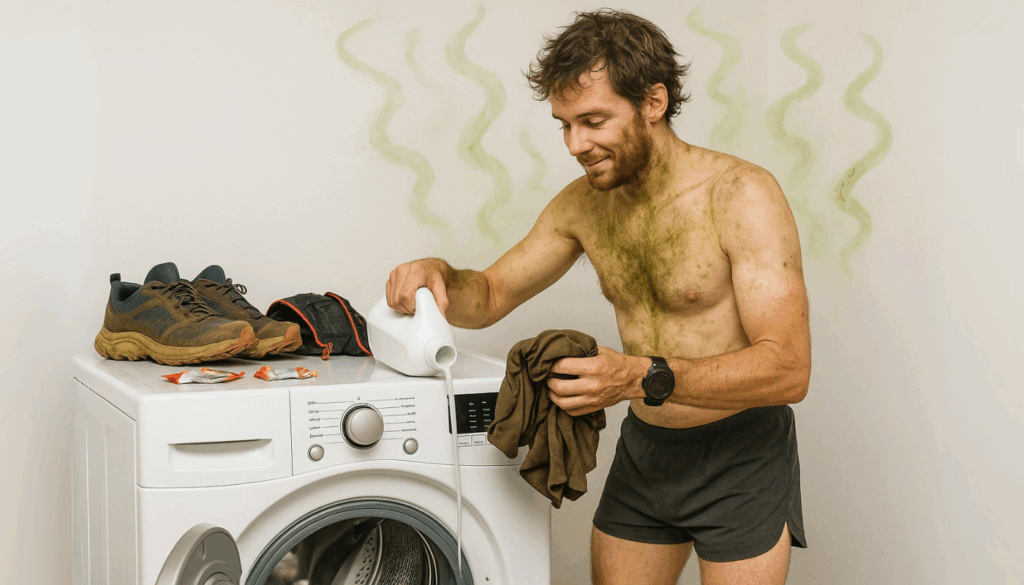Tired of smelly running clothes? Learn why technical fabrics hold onto odor and discover the best ways to remove sweat stink from workout gear—no vinegar baths or freezer tricks required.
No matter how diligently they’re washed, running and workout clothes start to smell over time. Luckily, getting odors out of your favorite running clothes isn’t all that hard, once you know what to do.
First off, why do running clothes continue stinking even after a wash? There are two factors at work here: technical fabrics and conventional detergents.
The same thing that makes for a good piece of technical clothing—its ability to wick moisture away from your skin and spread it over a wide surface area for quick evaporation—makes it a haven for bacterial growth. Odor-causing bacteria get lodged among the fibers alongside sweat and body oils which they then feast on, spurring more growth.
A run through the washing machine will remove much of the sweat and oil, but often the bacteria remain in place. Conventional detergent and fabric softeners also leave behind residue, which essentially clogs up the fabric and impairs its ability to wick effectively, creating an even more bacteria-friendly environment.
Now that we understand where the funk comes from, how do we get rid of it? You may have tried some home remedies: using white vinegar (a great way to smell like pickles even before spilling brine all over yourself at an aid station…not that I have first-hand experience); soaking clothes in baking soda and vinegar (a great blend of running and elementary school volcanology); “stripping” your clothes for a few hours in a solution of detergent and borax; or even putting smelly clothes in the freezer overnight. I passed on that last one.
All these options may help to some extent (except the freezing one), but the most effective, and easiest, way to get your clothes back to smelling fresh is to use a technical deodorizing cleaner to go with your technical clothes.
There are a handful of these purpose-made deodorizing, non-detergent cleaners on the market, but the one I’ve found most effective is Sports Refresh from Nikwax.
Nikwax, a UK-based manufacturer of environmentally friendly technical cleaning and waterproofing products, has been at the cleaning game since the 70s. They’re best known for Tech Wash, which is great for cleaning and refreshing waterproof layers without ruining their waterproofness or breathability.
In addition to removing lingering smells, Sports Refresh also improves clothes’ wicking ability, meaning they perform better, dry faster, and smell nicer for longer.
In my own testing, consisting of washing my and my wife’s favorite—and thus smelliest—running clothes, I noticed an immediate improvement in both the smell and the duration of freshness. For instance, I washed my favorite shirt, a 3-year-old synthetic tee with a distinctly pungent funk, and while the odor did eventually return after several runs, it was noticeably less intense.

Keep in mind that no product is going to be able to restore well-loved running clothes to their original state. Heidi Allen, vice president of marketing for Nikwax, uses hockey pads that have been fermenting in someone’s bag for months as an example.
“If you were to take the gnarliest thing you can think of and use Sports Refresh, it’s not going to get rid of all that funk. It’s not a miracle,” she says, “but it does a great job of removing fairly persistent odors and then helping to prevent future odor buildup.”
Allen also has some tips for those without a washing machine in their home. If you’re using a laundromat or other shared laundry facilities, make sure to check the machine’s detergent dispenser for buildup. According to Allen, “some of them have so much detergent buildup in them that some of that could inadvertently get in” and negate the effectiveness of the deodorizing cleaner.
And if you have no access to laundry facilities (I’m looking at you, #VanLifers), or the smell is especially bad, Allen suggests you ditch the washing machine and use whatever you have available—your bathtub, your sink, or wherever is convenient. Just add water, your deodorizing cleaner of choice, and your stinky clothes, and massage the cleaner in. This method has the added benefit of giving especially rank clothes a more concentrated hit of cleaner.
As runners, we feel the truth of the adage “an ounce of prevention is worth a pound of cure” deep in our constantly niggling bones, muscles, and joints. It’s just as true with odors as it is with injuries, so here are some ways to keep the funk from setting in.
☀️ Let your clothes dry. It may be common sense, but hang your sweaty clothes up to dry at the end of your runs. This won’t necessarily make your clothes smell better immediately, but it goes a long way towards minimizing bacterial growth.
💦 Wash your clothes frequently. The longer your clothes go between washes, the more time bacteria have to multiply and funk has to set in. There are, of course, important considerations that will affect how often you wash your clothes—things like water usage and access to laundry facilities—but when it comes to keeping the smell away, more often is usually better. If a wash isn’t possible, give your sweaty clothes a quick rinse right after use.
🧼 Avoid fabric softener. Fabric softener is not designed for technical clothes. It leaves behind residue that impairs wicking and feeds bacteria. Just say no to fabric softener.
🚫 Ditch your detergent. When it comes to running clothes, you really want it performing—and smelling—its best, so why not switch to a performance-enhancing cleaner entirely for those items? Allen notes that a good deodorizing, non-detergent cleaner is a great substitute for regular detergent. “And if you’re using it early on in the garment’s life, it’ll really help resist that odor buildup that does happen as well as removing it when you wash it.”
🧦 Wear wool clothes. Merino wool is an excellent temperature regulator, wicks moisture efficiently, and is naturally anti-microbial, so it’s less likely to start smelling in the first place. In the summer months or in hot climates, wool may not be the most practical choice, but it’s an excellent option for the cool shoulder seasons and winter running. And you can wash it just like the rest of your technical clothes.

That covers running clothes, but what about all those pieces you don’t want to throw in the washing machine? For me that’s my vest and hats—items I don’t want to get beaten up and prematurely worn out in the wash.
Your best bet is to use the tub method Allen described earlier. Drop them in the water/cleaner solution and let them soak it in. If your vest is especially gross, grab a brush and give the sweatiest parts—the shoulders and back—a good scrub. I also like to rinse my vest in my post-run shower to keep it from developing an odor in the first place.
And there you have it; all your smelly clothes can be (like) new again! Plus, you’re doing your part to further sustainability by keeping your gear where it belongs—on the trails and out of the landfill. As Allen puts it, “fight planned obsolescence!”
Every few months I put my running vest through the wash inside a laundry bag. The bag keeps it safe and contains all the cords, ties, elastics etc. Works great !
Pro tip: add cleaner to the washing machine, not the floor. 😉
Thanks very much for sharing!
Use a non-scented laundry detergent and wash on deep water setting, soak, and deep water rinse. The cycle takes forever, but everything comes out smelling fresh.